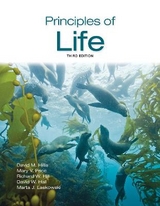
Principles of Life
W.H.Freeman & Co Ltd (Verlag)
978-1-4641-0947-8 (ISBN)
- Titel erscheint in neuer Auflage
- Artikel merken
Well esteemed authors within the biology field, David Hillis and David Sadava, worked on remaking a text that would fit the modern biology classroom. Main features include chapter opening stories that set up an interesting question in a recognisable real-world setting for your students. The investigation figures describe a key experiment and hypothesis that students have to analyse and work with given data to come to conclusions. Principles of Life is available with LaunchPad. LaunchPad combines an interactive ebook with high-quality multimedia content and ready-made assessment options, including LearningCurve adaptive quizzing. See ‘Instructor Resources’ and ‘Student Resources’ for further information.
David M. Hillis is the Alfred W. Roark Centennial Professor in Integrative Biology at the University of Texas at Austin, where he also has directed the Center for Computational Biology and Bioinformatics and the School of Biological Sciences. Dr. Hillis has taught courses in introductory biology, genetics, evolution, systematics, and biodiversity. He has been elected to the National Academy of Sciences and the American Academy of Arts and Sciences, awarded a John D. and Catherine T. MacArthur Fellowship, and has served as President of the Society for the Study of Evolution and of the Society of Systematic Biologists. David E. Sadava is the Pritzker Family Foundation Professor of Biology, Emeritus, at the Keck Science Center of Claremont McKenna, Pitzer, and Scripps, three of The Claremont Colleges. In addition, he is Adjunct Professor of Cancer Cell Biology at the City of Hope Medical Center. Twice winner of the Huntoon Award for superior teaching, Dr. Sadava has taught courses on introductory biology, biotechnology, biochemistry, cell biology, molecular biology, plant biology, and cancer biology. Richard W. Hill is Professor in the Department of Zoology at Michigan State University and a frequent Guest Investigator at Woods Hole Oceanographic Institution. He received his Ph.D. in Zoology from the University of Michigan. Mary V. Price is Professor of Biology, Emerita, at the University of California, Riverside and Adjunct Professor in the School of Natural Resources and the Environment at the University of Arizona. In “retirement,” she continues to teach and study, having learned the joy and art of scientific discovery as an undergraduate student at Vassar College and doctoral student at the University of Arizona.
PART 1: CELLS 1. Introduction.- 2. The Chemistry and Energy of Life.- 3. Nucleic Acids, Proteins, and Enzymes.- 4. Cells: The Working Units of Life.- 5. Cell Membranes and Signaling.- 6. Pathways that Harvest and Store Chemical Energy.- PART 2: GENETICS 7. The Cell Cycle and Cell Division.- 8. Inheritance, Genes, and Chromosomes.- 9. DNA and Its Role in Heredity.- 10. From DNA to Protein: Gene Expression.- 11. Regulation of Gene Expression.- 12. Genomes.- 13. Biotechnology.- 14. Genes, Development, and Evolution.- PART 3: EVOLUTION 15. Processes of Evolution.- 16. Reconstructing and Using Phylogenies.- 17. Speciation.- 18. The History of Life on Earth.- PART 4: DIVERSITY 19. Bacteria, Archaea, and Viruses.- 20. The Origin and Diversification of Eukaryotes.- 21. The Evolution of Plants.- 22. The Evolution and Diversity of Fungi.- 23. Animal Origins and Diversity.- PART 5: PLANT FORM AND FUNCTION 24. The Plant Body.- 25. Plant Nutrition and Transport.- 26. Plant Growth and Development.- 27. Reproduction of Flowering Plants.- 28. Plants in the Environment.- PART 6: ANIMAL FORM AND FUNCTION 29. Fundamentals of Animal Function.- 30. Nutrition and Digestion.- 31. Breathing.- 32. Circulation.- 33. Muscle and Movement.- 34. Neurons, Sense Organs, and Nervous Systems.- 35. Nervous and Endocrine Control.- 36. Water and Salts: Excretion.- 37. Animal Reproduction.- 38. Animal Development.- 39. Immunology: Animal Defense Systems.- 40. Animal Behavior.- PART 7: ECOLOGY 41. The Distribution of Earths Ecological Systems.- 42. Populations.- 43. Ecological and Evolutionary Consequences of Interactions within and among Species.- 44. Ecological Communities.- 45. The Global Ecosystem.
| Zusatzinfo | 915 p. |
|---|---|
| Sprache | englisch |
| Maße | 229 x 279 mm |
| Themenwelt | Schulbuch / Wörterbuch ► Wörterbuch / Fremdsprachen |
| Naturwissenschaften ► Biologie | |
| ISBN-10 | 1-4641-0947-8 / 1464109478 |
| ISBN-13 | 978-1-4641-0947-8 / 9781464109478 |
| Zustand | Neuware |
| Haben Sie eine Frage zum Produkt? |
aus dem Bereich



